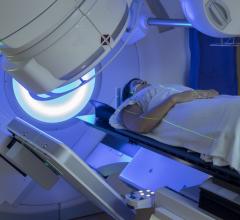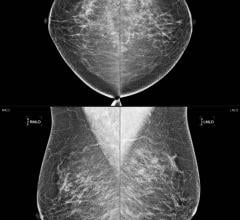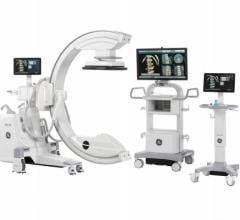
John Carrino, M.D., M.Ph., presents “Challenges and Opportunities for Radiology to Prove Value in Alternative Payment Models” at AHRA 2019. Photo by Greg Freiherr
Efforts to reform healthcare are booming, but finding one that will work well is a challenge.
Citing the need to control soaring costs, payers continue trying to reform healthcare. The shift from volume- to value-based imaging is one of these efforts. And it is gathering momentum. Unfortunately, determining the value of imaging is not easy.
In a July 21 Association for Medical Imaging Management (AHRA) 2019 session titled “Challenges and Opportunities for Radiology to Prove Value in Alternative Payment Models,” John Carrino, M.D., M.Ph., said radiology practices need to be engaged in the value paradigm. This is the most important point the vice chairman of radiology and imaging at the Hospital for Special Surgery (which ranked number one nationally in orthopedics and rheumatology for 2018-2019 by U.S. News and World Report) said he hoped people would get from his session.
Focusing on value “doesn’t mean that you don’t have volume,” Carrino told Imaging Technology News. “And it doesn’t mean that you buy into all these models,” he said, noting that payment models can change. “But you need to be aware of (alternate payment models) and have a strategy that works for your practice.” He emphasized that different practices may have different strategies.
In the session, Carrino detailed the proliferation of these models, noting recent emphasis on payment bundling and increasing interest in outcomes measures. Value has become an important focus.
“If you have high-quality imaging, does it influence decision-making?” he asked during the session. “Can it save money?”
An Evolving Lexicon
One of the challenges to answering these questions is the ambiguity that may be found in radiology reports, Carrino said. This may occur when radiologists use different terms to mean the same thing, he said.
“We haven’t done a good job of harmonizing our lexicon,” he explained, noting after the session that radiologists need to “make sure we have a uniform lexicon that we can define our data structures and identify our workflows.”
Although imaging may contribute to only a small part of each dollar spent on healthcare in the U.S., it is widely seen as a major source of health care costs. Most expenditures, according to a slide shown during the session and attributed to America’s Health Insurance Plans (AHIP), are for prescription drugs. But Carrino cited a JAMA report published in 2018 stating that health care utilization in the U.S. was out of step with that of other major countries.
The number of imaging exams may not be as important as their collective price, he said during the AHRA session. The key is determining the value of imaging.
Comparative research that establishes the contribution of different modalities under different circumstances could help, he said. But such research needs to determine the value of imaging performed during routine practices, not necessarily under ideal circumstances. Although investment in comparative effectiveness research may be important, according to Carrino, so may be the study of patient-centered outcomes measures.
Ordering Tests
Regardless of reimbursement models, the radiologists’ job description has remained largely unchanged. Radiologists are supposed to fill imaging orders prescribed by clinicians. But clinicians may delegate the ordering of scans to their staff. (One member of the audience noted after the session that nurses may be asked to write imaging orders.)
Confusion can result. The radiologist may wonder why the clinician wanted the scan — and to ask “maybe I can help,” Carrino said.
Radiologists could be more involved in test selection, he said, but this should be done “in a streamlined way.” Artificial intelligence could help “by gathering the context-specific information that we would need,” he said. Clinical decision support, which is currently being looked at by the Federal government, might help as well.
Greg Freiherr is a contributing editor to Imaging Technology News. Over the past three decades, Freiherr has served as business and technology editor for publications in medical imaging, as well as consulted for vendors, professional organizations, academia, and financial institutions.
Editor’s note: This article is the fifth piece in a content series by Greg Freiherr covering The Association for Medical Imaging Management (AHRA) annual meeting in Denver. The first article, How Standardizing Protocols Can Save Time and Money, can be found here. The second article, How Artificial Intelligence Might Impact Radiology, can be found here. The third article, How To Manage Risk in the MR Suite, can be found here. The fourth article, DR Advances Promote Imaging of Whole Spine, can be found here.
Related content:
FFR-CT: Is It Radiology or Cardiology?
DR Advances Promote Imaging of Whole Spine
How Standardizing Protocols Can Save Time and Money
How Artificial Intelligence Might Impact Radiology
How To Manage Risk in the MR Suite
CMS Proposes New Alternative Payment Model for Radiation Oncology
Johns Hopkins Named Qualified Provider-led Entity to Develop Criteria for Diagnostic Imaging

 August 29, 2024
August 29, 2024 








